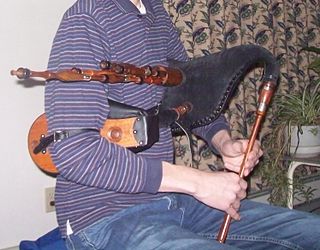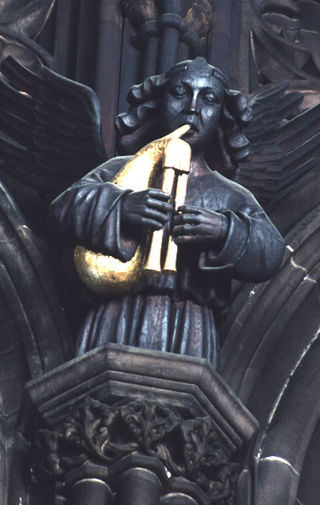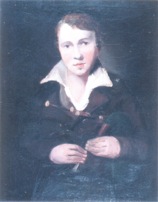Related Research Articles

Bagpipes are a woodwind instrument using enclosed reeds fed from a constant reservoir of air in the form of a bag. The Great Highland bagpipes are well known, but people have played bagpipes for centuries throughout large parts of Europe, Northern Africa, Western Asia, around the Persian Gulf and northern parts of South Asia.

The uilleann pipes, sometimes called Irish Bagpipes, are the characteristic national bagpipe of Ireland. Earlier known in English as "union pipes", their current name is a partial translation of the Irish language terms píobaí uilleann, from their method of inflation. There is no historical record of the name or use of the term uilleann pipes before the 20th century. It was an invention of Grattan Flood and the name stuck. People mistook the term 'union' to refer to the 1800 Act of Union; this is incorrect as Breandán Breathnach points out that a poem published in 1796 uses the term 'union'.

The chanter is the part of the bagpipe upon which the player creates the melody. It consists of a number of finger-holes, and in its simpler forms looks similar to a recorder. On more elaborate bagpipes, such as the Northumbrian bagpipes or the Uilleann pipes, it also may have a number of keys, to increase the instrument's range and/or the number of keys it can play in. Like the rest of the bagpipe, they are often decorated with a variety of substances, including metal (silver/nickel/gold/brass), bone, ivory, or plastic mountings.

The great Highland bagpipe is a type of bagpipe native to Scotland, and the Scottish analogue to the great Irish warpipes. It has acquired widespread recognition through its usage in the British military and in pipe bands throughout the world.

The Scottish smallpipe is a bellows-blown bagpipe re-developed by Colin Ross and many others, adapted from an earlier design of the instrument. There are surviving bellows-blown examples of similar historical instruments as well as the mouth-blown Montgomery smallpipes, dated 1757, which are held in the National Museum of Scotland. Some instruments are being built as direct copies of historical examples, but few modern instruments are directly modelled on older examples; the modern instrument is typically larger and lower-pitched. The innovations leading to the modern instrument, in particular the design of the reeds, were largely taken from the Northumbrian smallpipes.

The Northumbrian smallpipes are bellows-blown bagpipes from Northeastern England, where they have been an important factor in the local musical culture for more than 250 years. The family of the Duke of Northumberland have had an official piper for over 250 years. The Northumbrian Pipers' Society was founded in 1928, to encourage the playing of the instrument and its music; Although there were so few players at times during the last century that some feared the tradition would die out, there are many players and makers of the instrument nowadays, and the Society has played a large role in this revival. In more recent times the Mayor of Gateshead and the Lord Mayor of Newcastle have both established a tradition of appointing official Northumbrian pipers.
Here Northumbria is defined as Northumberland, the northernmost county of England, and County Durham. According to 'World Music: The Rough Guide', "nowhere is the English living tradition more in evidence than the border lands of Northumbria, the one part of England to rival the counties of the west of Ireland for a rich unbroken tradition. The region is particularly noted for its tradition of border ballads, the Northumbrian smallpipes and also a strong fiddle tradition in the region that was already well established in the 1690s. Northumbrian music is characterised by considerable influence from other regions, particularly southern Scotland and other parts of the north of England, as well as Irish immigrants.
The Northumbrian Pipers' Society was founded to promote both types of Northumbrian bagpipes – the Northumbrian smallpipes and the half-long pipes, now generally known as the Border pipes. There had been several attempts to encourage the pipes and their music during the 19th century, but no society was formed with this specific aim until the Northumbrian Small Pipes Society in 1893. That society organised a series of competitions, in which Richard Mowat and Henry Clough were both prizewinners. However it was short-lived, dissolving around 1899. Today the society is divided into two branches, the main branch based in Morpeth, and the Cleveland branch based in Sedgefield.

The pastoral pipe was a bellows-blown bagpipe, widely recognised as the forerunner and ancestor of the 19th-century union pipes, which became the uilleann pipes of today. Similar in design and construction, it had a foot joint in order to play a low leading note and plays a two octave chromatic scale. There is a tutor for the "Pastoral or New Bagpipe" by J. Geoghegan, published in London in 1745. It had been considered that Geoghegan had overstated the capabilities of the instrument, but a study on surviving instruments has shown that it did indeed have the range and chromatic possibilities which he claimed.

Welsh bagpipes The names in Welsh refer specifically to a bagpipe. A related instrument is one type of bagpipe chanter, which when played without the bag and drone is called a pibgorn (English:hornpipe). The generic term pibau (pipes) which covers all woodwind instruments is also used. They have been played, documented, represented and described in Wales since the fourteenth century. A piper in Welsh is called a pibydd or a pibgodwr.
This article defines a number of terms that are exclusive, or whose meaning is exclusive, to piping and pipers.

The William Dixon manuscript, written down between 1733 and 1738 in Northumberland, is the oldest known manuscript of pipe music from the British Isles, and the most important source of music for the Border pipes. It is currently located in the A.K. Bell Library, Perth, Scotland. Little is known of William Dixon's biography, except what has been learned from this manuscript, and from parish records in Northumberland.
John Peacock was one of the finest Northumbrian smallpipers of his age, and probably a fiddler also, and the last of the Newcastle Waits. He studied the smallpipes with Old William Lamshaw, of Morpeth, and later with Joseph Turnbull, of Alnwick.

When bagpipes arrived in England is unknown, there is some evidence to suggest Anglo-Saxon times, however the oldest confirmed proof of the existence of bagpipes anywhere in the world comes from three separate sources in the 13th century. Two of them English; the Tenison Marginalie Psalter from Westminster and an entry into the accounts books of Edward the I of England recording the purchase of a set of bagpipes. The third from the Cantigas Del Santa Maria published in Spain. From the 14th century onwards, bagpipes start to appear in the historical records of European countries, however half the mentions come from England suggesting Bagpipes were more common in England.
Robert Reid is widely acknowledged as the creator of the modern form of the Northumbrian Smallpipes. He lived and worked at first in Newcastle upon Tyne, but moved later to the nearby town of North Shields at the mouth of the Tyne, probably in 1802. North Shields was a busy port at this time. The Reids were a family with a long-standing connection to piping; Robert's father Robert Reed (sic), a cabinet maker, had been a player of the Northumbrian big-pipes, and an associate of James Allan, his son Robert was described later by James Fenwick as a beautiful player as well as maker of smallpipes, while Robert's son James (1814–1874) joined his father in the business. Robert died in North Shields on the 13th or 14 January 1837, and his death notice in the Newcastle Journal referred to him as a "piper, and as a maker of such instruments is known from the peer to the peasant, for the quality of their tone, and elegance of finish". He is buried in the graveyard of Christ Church, North Shields. His wife Isabella died in 1849, of cholera. There were repeated outbreaks of the disease at this time especially in the poor 'low town', near the river, where the Reids lived.
Colin Ross was an English folk musician who played fiddle and Northumbrian smallpipes. He was a noted maker of Northumbrian smallpipes, border pipes and Scottish smallpipes, and one of the inventors of the modern Scottish smallpipes.

Robert Elliot Bewick (1788–1849) was the son of the engraver Thomas Bewick. He was trained in engraving by his father, but is primarily remembered now as a player of the Northumbrian smallpipes.
The Rook manuscript, a music manuscript compiled by John Rook, of Waverton, Cumbria in 1840, is "A Collection of English, Scotch, Irish and Welsh tunes, containing upwards of 1260 airs". These include many tunes, or versions of tunes, not found elsewhere. It is a particularly valuable resource for the study of the traditional music of Northern England, and specifically of music for the Northumbrian Smallpipes.
Cornelius Stanton was a mid-19th-century Northumbrian piper.
References
- ↑ "LBPS | Another 17th Century Piper". lbps.net.
- ↑ Colls, Robert (2019). Northumbria: History and Identity 547-2000. Phillimore & Co Ltd. ISBN 978-0750990431.
- ↑ "National Museums of Scotland - Set of Northumbrian or Half-long bagpipes". Nms.scran.ac.uk. Retrieved 12 January 2021.
- ↑ "Collection Detail". Archived from the original on 2017-09-05. Retrieved 2017-09-04.
{{cite web}}: CS1 maint: unfit URL (link) - ↑ "Collection Detail". October 12, 2016. Archived from the original on 2016-10-12.
{{cite web}}: CS1 maint: unfit URL (link) - ↑ "Out of the Flames", compiler Roderick D. Cannon, Lowland and Border Pipers'Society, 2004, ISBN 9780952271116.
- ↑ The Master Piper – Nine Notes That Shook the World, William Dixon (1733), 3rd edition, edited Matt Seattle 2011, ISBN 978-1-872277-33-2.
- ↑ John of the Green, the Cheshire Way, 2nd edition, John Offord 2008, ISBN 978-0-9556324-0-2
- ↑ "FARNE archive". Archived from the original on 2007-09-28. Retrieved 2009-06-13.
- ↑ [Matt Seattle Article on Border Piping] "The Pipers' Gathering - North America's most comprehensive alternative bagpipe event". Archived from the original on May 3, 2009. Retrieved January 27, 2009.
{{cite web}}: CS1 maint: bot: original URL status unknown (link)